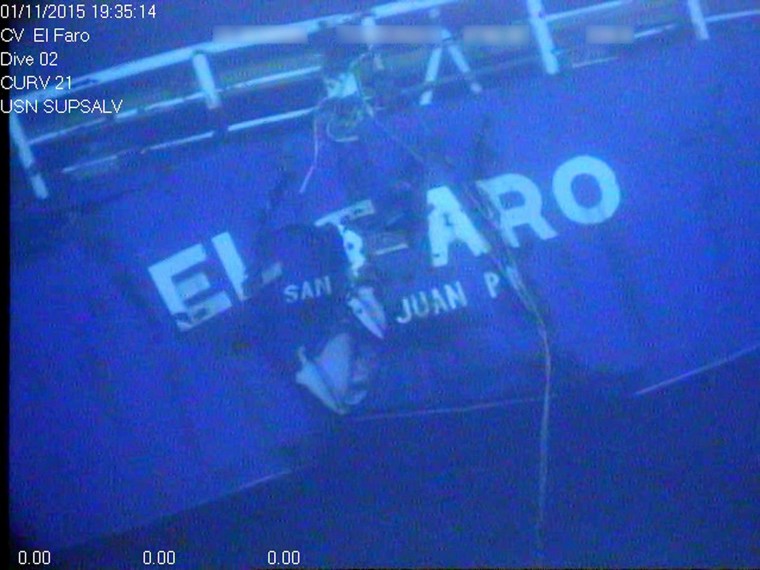Crew members aboard a doomed cargo ship expressed increasingly dire concern — occasionally tinged with gallows humor — as a hurricane gained strength, culminating in one crewman lamenting "I'm a goner" as they scrambled to abandon the listing ship, transcripts released Tuesday show.
The 500 pages of transcripts provide a new glimpse at the final hours for the crew of 33, all of whom died when El Faro sank in October 2015. Some of those on board questioned the captain's decision to sail closer to Hurricane Joaquin, which took an erratic path as it swirled in the Atlantic.
Audio recovered last summer from the ship's resting place 15,000 feet deep near the Bahamas recorded conversations on the ship's bridge, along with weather and positioning data.
"Nobody in their right mind would be drivin' into it," one crewmember said of the hurricane, the afternoon before the ship sank.
"We are. Yaaay," second mate Danielle Randolph responded with a sarcastic laugh.
Related: Voyage Data Recorder from Sunken El Faro Retrieved, NTSB Says
Instead of rerouting or returning to Jacksonville, Capt. Michael Davidson decided to watch the storm closely through the night. He thought the storm would be worse on the journey back to Jacksonville from Puerto Rico and emailed officials at the company that owned the ship, Tote Maritime Inc., to ask if he could take what he thought would be a safer route on that return trip.
Davidson said he hadn't heard back. "It's 160 more miles. That's more fuel. You know?" he replied.
Eventually, a Tote official did respond "authorized." U.S. Coast Guard investigators have raised questions about whether Davidson was under time pressure and chose the more dangerous, direct route. Davidson's wife, Theresa, has said he was safety-conscious, getting in trouble with a different company when he refused to take out a ship that had steering problems.
In a statement to The Associated Press, Tote denied having any say over Davidson's voyage planning, saying it was up to him.
"Our crews are trained to deal with unfolding weather situations and are prepared to respond to emerging situations while at sea," the company said.
Related:El Faro Owner Settles With Families of Sunken Ship's Crew Members
Back on the ship, Davidson left the bridge around 8 p.m. to get some rest, telling his crew to monitor the weather. As the night progressed, some crew questioned why Davidson didn't take a safer, longer route to San Juan — the same route it took during Tropical Storm Erika a month earlier.
"Guess I'm just turnin' into a Chicken Little, but I have a feeling like something bad is gonna happen," third mate Jeremie Riehm said while on watch at about 10:40 p.m.
As the clock ticked past midnight, the crew steering the ship started discussing their survival suits and whether their emergency beacons were working.
The El Faro had dipped south a bit to try and skirt the storm, but "every time we come further south the storm keeps trying to follow us," Randolph said, telling a colleague with a laugh that "all the other ships high-tailed it away."
Then, a news alert came over the radio: Joaquin had grown into a major Category 3 storm.
"Oh my God," she said.
Three minutes later, at 1:15 a.m., the ship rolled hard from a big wave.
At 2:47 a.m., the ship continued getting battered by large waves. The second mate called Davidson in his state room; it took him a few rings to pick up.
He appeared on the bridge at 4:09 a.m., according to the transcripts. He immediately set out to calm nerves.
"Well, this is every day in Alaska," he told chief mate Steven Shultz and another able seaman. About a half-hour later, Shultz said the engineer called because the ship was tilting and oil levels were problematic. A crew member said El Faro had never listed like that, but Davidson replied things would get better.
They didn't. At 5:43 a.m., one of the ship's cargo holds began flooding. Davidson sent Shultz to pump it out. He also tried turning the ship to get the wind to help stabilize things.
A half-hour later, the ship lost propulsion. Davidson called Tote to report the situation as water continued pouring into the hold.

At 7:24, Davidson says: "We're definitely not in good shape right now." Five minutes later, the high frequency ringing of the abandon ship alarm is heard. The captain, Randolph and another crew member discuss grabbing their life vests. But within moments, the captain says: "Bow is down."
Davidson tells everyone to get off the ship, but a seaman is paralyzed by fear and says to Davidson: "Help me. Help me."
"Don't panic," Davidson says. "Work your way up here."
"I'm a goner," the seaman says.
"No you're not," Davidson replies.
Moments later, at 7:39 a.m., only yelling is heard before the recording stops.
Follow Jason Dearen on Twitter: http://www.twitter.com/JHDearen